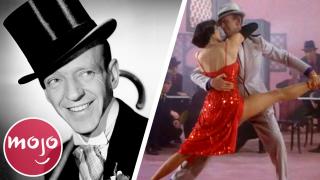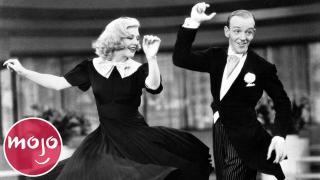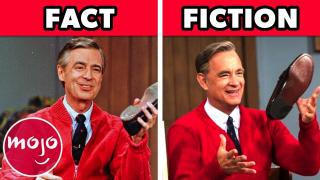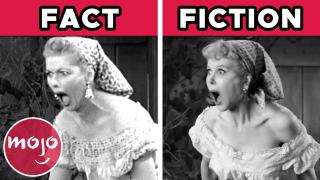Top 10 Things A Beautiful Day in the Neighborhood Got Factually Right
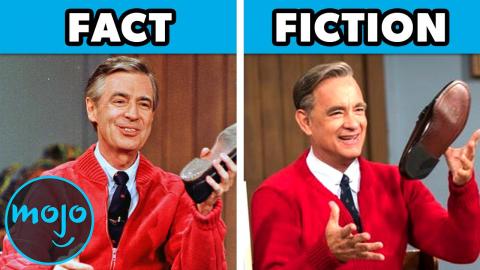
#10: Mister Rogers Took Pictures to Document His Life
“A Beautiful Day in the Neighborhood” depicts Fred Rogers as someone who’s always living in the now, taking pictures to immortalize certain moments and people. The Esquire journalist who’s sent to interview Rogers, referred to as Lloyd Vogel in the film, is caught off-guard when Fred wants a snapshot of him. According to the original article, Rogers really did break out a camera and ask if he could take the writer’s picture. Rogers reportedly said, “I’d like to take your picture. I like to take pictures of all my new friends, so that I can show them to Joanne…” Documentary filmmaker Benjamin Wagner claims that Rogers preferred taking pictures rather than being photographed himself, another detail this movie gets down.
#9: Fred & the Journalist Remained in Contact
Top 20 Iconic Fred Astaire Dance Scenes
Speaking of photos, there’s a scene in the film’s final act where Rogers takes a picture of Vogel’s family after they all share some pie. While this moment does feel like a stretch, Fred and the Esquire journalist did form a lasting bond. Even if they didn’t constantly see each other in person per se, they remained in close contact via email well after the article was published in 1998. In a 2019 article published by The Atlantic, Tom Junod looked back on his friendship with Rogers. “For as long as I knew him, we corresponded,” he wrote. He added towards the end of the article, “He gave so much to me, so much trust and friendship, without asking me to earn it.”
#8: Rogers Was Advised Against Doing the Interview
Top 10 Fred Astaire & Ginger Rogers Dance Scenes
Early on in the film, Vogel is told by his editor that Rogers is the only person who will do an interview with him. All the other celebrities said no due to Vogel’s reputation. It’s also strongly hinted that those who work with Rogers aren’t thrilled about Vogel, feeling that he’ll paint everyone’s favorite neighbor in a negative light. Nevertheless, Rogers ignores all warning signs and welcomes Vogel with open arms. In reality, Rogers’ co-workers did advise him against speaking with the Esquire journalist, pointing out that it could damage his image. Even though people allegedly thought he was “crazy” for saying yes, Rogers remained true to character and decided to see the good in humanity rather than the bad.
#7: Rogers Was Overweight as a Child
Although Rogers was a beacon of optimism, his life wasn’t without hardships. At one point in the movie, Rogers tells Vogel that he was bullied as a child for being overweight. According to Morgan Neville, who directed the documentary “Won’t You Be My Neighbor”: “People called him Fat Freddy and he made a very willful decision that that’s not gonna be who I am for the rest of my life and I never was.” By the time Rogers was grown up, he weighed a healthy 143 pounds and he strived to maintain that exact weight. This number was so special to Rogers that he reportedly said, “143 means ‘I love you.’”
#6: The Time Rogers Couldn’t Put Up a Tent
Top 10 Things A Beautiful Day in the Neighborhood Got Factually Right
During a taping of the show, Vogel bears witness to an unscripted incident where Rogers struggles to put up a camping tent. Rogers ultimately can’t get the tent set up properly, but he decides against doing another take. A few liberties are taken here, as this particular episode aired in 1975, decades before Rogers’ Esquire interview took place. Also, in the finished episode, we never see Rogers wrestle with the tent. Instead, it’s already been assembled when Rogers walks outside. However, Rogers did in fact have a hard time unfolding the tent, which was captured on camera. While this lengthy blooper wasn’t featured on the show, Rogers did share it on a 1982 episode of “Late Night with David Letterman,” demonstrating that nobody’s perfect.
#5: Mister Rogers Was an Avid Swimmer
Throughout a montage, Rogers is seen doing laps in a swimming pool. This sequence is faithful to the real-life Rogers, who swam “nearly every morning of his life,” according to the Esquire article. In 1997, a year before “Can You Say... Hero?” was published, a 69-year-old Rogers was the focus of a Los Angeles Times article entitled, “Can You Say ‘Avid Swimmer?’” When asked how often he would swim, Rogers responded, “Every day between 7 and 8:30 before work. I swim 25 minutes hard and this is in a 75-foot pool. I used to swim at the lunch break, but that was too discombobulating for the schedule maker.” Rogers proceeded to say that he had been keeping this routine up for 35 years.
#4: The Esquire Journalist Was Seen as a “Bad Boy”
Top 10 Things Being the Ricardos Got Factually Right & Wrong
As mentioned before, the film establishes upfront that Vogel is a rogue journalist who isn’t afraid to ask personal questions. Vogel may be an award-winning writer, but no big names want to do an interview with a quote unquote “bad boy.” This is true to the actual Esquire journalist, Junod, who had landed in hot water prior to interviewing Rogers. The article in question that garnered him such a notorious reputation was entitled “Kevin Spacey Has a Secret,” which made coy insinuations about the actor’s sexuality. This particular article doesn’t get singled out here, but considering the more recent news revolving around Spacey, we get why the filmmakers would want to leave his name out of a PG movie.
#3: Rogers’ “The Arsenio Hall Show” Appearance
One of the more surreal moments in the film finds Rogers on “The Arsenio Hall Show.” Hall gives Rogers a multi-colored leather jacket, which closely resembles his own. Not only did this happen in 1993, but the actual television footage was used in the film. Of course, the real Fred Rogers is swapped out with Tom Hanks through the magic of special effects. Hanks’ performance is so uncanny, however, that it’s honestly like seeing double. The question that remains is if Rogers ever hung the jacket he got from Hall alongside his cardigans?
#2: Rogers’ Vegetarianism
Sitting down to a meal together, Vogel can’t help but notice that Rogers is only eating vegetables. Rogers tells Vogel that he can’t bring himself to eat something that has a mother, which is a phrase he regularly said. Rogers reportedly cut meat out of his diet during the early ‘70s upon reading “Diet for a Small Planet,” the first widespread book to address how meat production can negatively impact the environment. Frances Moore Lappé urged readers to practice vegetarianism and Rogers took her advice to heart. Before we get to our top pick, here are a few things the movie got wrong. The Journalist’s Name While he’s called Lloyd Vogel in the movie, the journalist who interviewed Rogers for Esquire is, of course, actually named Tom Junod. The Wedding Fistfight At his sister’s wedding in the film, Vogel gets into a heated confrontation with his father, leading to a fistfight between him and another guest. Junod clarified, though, that not only did he not get into a fight at his sister’s wedding, but his sister never had a wedding. The Journalist’s Father & Wife The film also changes the name of Tom Junod’s wife, who’s really named Janet, and Junod’s father, who was actually named Lou. The film made up a fair deal about his family dynamics as well, particularly the one he shared with his father. While Lou Junod was a “boozy philanderer,” as seen in the movie, Tom said that nonetheless: “I idolized my father, despite my mother’s warnings.”
#1: One Silent Minute
Top 10 Things Elizabeth (1998) Got Factually Right and Wrong
At the restaurant with Vogel, Rogers suggests setting aside “one silent minute” before eating. This is another quote that’s directly taken out of Rogers’ life. At the 24th Annual Daytime Emmy Awards, where he received a Lifetime Achievement Award, Rogers asked the audience to take ten seconds of silence. While giving his commencement address at Dartmouth College in 2002, Rogers asked attendees to take “one silent minute.” These instances really spoke to Rogers’ spiritual side, which Tom Junod felt came off as “extremely accurate” in the movie.


